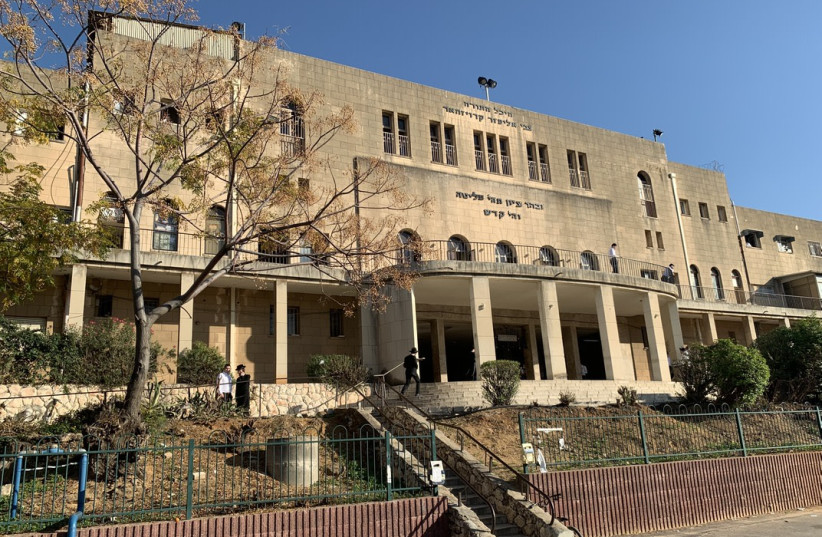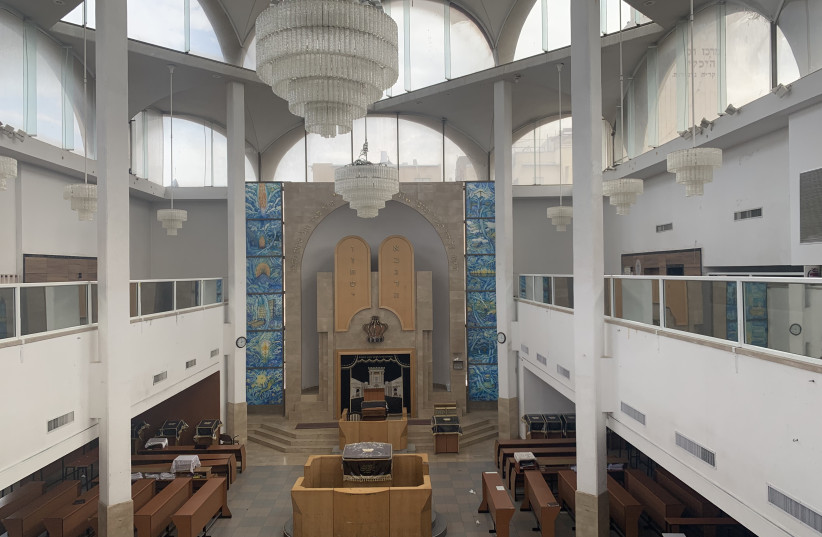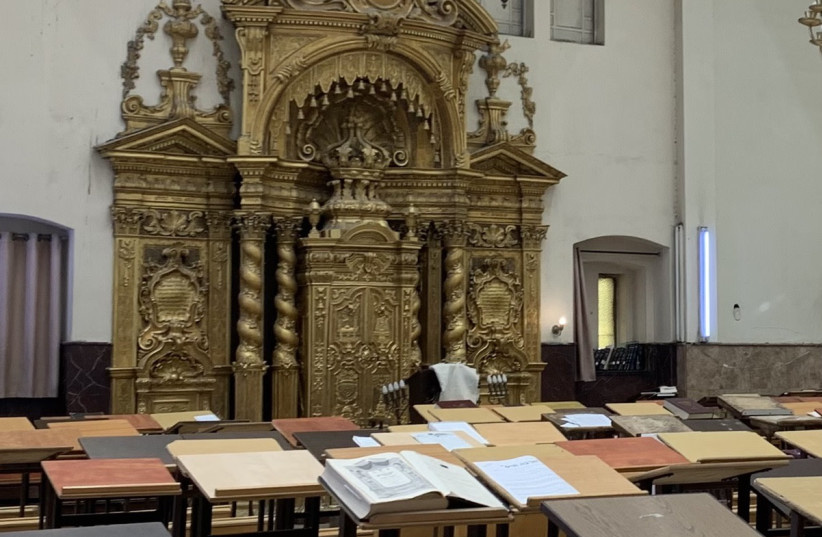Every Passover on Seder night, Bnei Brak gets a special mention from its five legendary scholars. They were so engrossed in studying the Israelites’ exodus from Egypt all through the night, that they didn’t notice the rising sun. Their students interrupted their passionate deliberations with “Our esteemed rabbis! Time to say the morning Shema.”
That spirit encapsulates the position of synagogues and prayer some 2,000 years later in today’s Bnei Brak, whose ancient, biblical site (Joshua 19:45) is less than an hour’s walk away. Here, the synagogues’ main functions are for prayer and Torah learning.
Many of the synagogues are packed with full-time yeshiva students and kollel [advanced Talmud] scholars. Like their learned historic predecessors, these men are immersed in study day and night, typically in pairs and in huge study halls. These double as synagogues, as the participants seamlessly move over from study to prayer in the same hall, in the same seats, and behind the same lecterns.
Intensive and demanding forms of Torah Judaism: What is the modern Bnei Brak?
Today, Bnei Brak is a powerhouse of intensive and demanding forms of diverse Torah-Judaism expressions. These institutions support tens of thousands of full-time students and scholars who hail from Israel and abroad. They will tell you that the Torah (as especially expressed by the Talmud and the halachic codes) is where the Creator and His people interface. The more prolonged, regular and rigorous the immersion, the more spiritually sustained is the entirety of Jewish observance. Through it, the whole of life and all that supports it is also sustained.
This highly idealist, intense, and distinctive community did not emerge by accident but through the driving force of a few far-sighted, determined, economically successful, and devout visionaries a hundred years ago.

Modern Bnei Brak has its roots in eight strictly religious Polish-Jewish families who came on the fourth aliyah, between 1924 to 1928. They sold what they had in their home country as capital for the creation of a new community – then a scorpion- and mosquito-infested wasteland beyond the burgeoning city of Tel Aviv.
The pioneering leader, Rabbi Yitzchak “Itche” Gerstenkorn, wasted no time in developing the site into citrus groves, and then into small, industrial enterprises. The hastily constructed shacks, which were utterly basic and drafty, served as their study hall for Torah learning, lectures and thrice-daily prayer. This simple existence contrasted with the comfortable quarters they had left in Warsaw.
It quickly attracted like-minded individuals, increasing to 800 people by 1928 when the more substantial Beit Haknesset Hagadol (the Great Synagogue) on Rabbi Akiva Street was completed.
In the following decade., the aliyah of Rabbi Avraham Yeshaya Karelitz, better known as the Chazon Ish (“vision of a man”) , transformed Bnei Brak’s nascent Torah character into a world-class Torah community. Declining an offer of a prestigious rabbinical position in Jerusalem, the Chazon Ish sensed that he was more needed in shaping the rich potential, but far less developed, community of Bnei Brak.
He envisaged Bnei Brak as a city where every aspect of life would be infused with Torah values, using his energies to inculcate ideals that exuded holiness.
With the demise of that way of life in Eastern Europe, urged the illustrious yeshivas of Ponevez and Slabodka to be transplanted to Bnei Brak – a place that he considered the mundane as holy; and the holy as the holy of holies.

Here, the streets on Shabbat and the Jewish festivals are closed to traffic, and a sense of the timeless entry to the world to come descends. Such a setting subsequently attracted many world-renowned spiritual leaders and yeshiva heads. These include the Ponevez’s Rabbi Yosef Shlomo Kahaneman; Rabbi Eliyahu Eliezer Dessler; Rav Elazar Shach; the “Steipler” Rabbi Yaakov Yisrael Kanievsky; and Rabbi Chaim Kanievsky.
They were later followed by hassidic centers and their spiritual leaders, many of whom moved to Bnei Brak from the less spiritually compatible Tel Aviv. These include the Vizhnitz, Nadvorna, Sanz, Biala, Slonim, Chernobyl, Trisk and Zutske hassidic dynasties.
IT IS possible for males to visit these study hall/synagogues, However, entry for females is restricted to separate entrances and galleries.
A good start for a visit is the Great Synagogue. Its core members – who tended to be Religious Zionist, with haredi standards of observance and dress – subsequently passed away or moved out of the community. When the structure was rebuilt 10 years ago, the remaining Religious Zionist and haredi communities reached a happy merger. The local regulars were joined by the fast-growing population of the prestigious Hebron Yeshiva of Jerusalem’s Givat Mordechai neighborhood, who were relocating to Bnei Brak.
The architect took special care to make those newcomers feel welcome. For instance, the six-meter-high Torah ark, as well as the arched windows, are reminiscent of Hebron Yeshiva. Two additional floors, with large study halls, double as synagogues and are filled with students at all hours of the day and night.
The Hebron Yeshiva started out as the Israel branch of Russia’s famed Slabodka Yeshiva. The yeshiva moved to Jerusalem after the 1929 Arab riots in Hebron. Following the Holocaust, the Slabodka Yeshiva’s presence in Israel expanded. The distinctive three-roofed Slabodka Yeshiva in Bnei Brak, on Harav Sher Street, is named after its founding director.
It is well worth a visit, as well as the Ponevez Yeshiva, with its beautiful gold-plated ark in the main study hall, imported from Mantua, Italy. It was originally designated to be the main synagogue of Ramat Gan, but following negotiations it ended up as the gem of the Ponevez Yeshiva in adjacent Bnei Brak.

When visiting yeshivas, attune your ears to the strangely soothing cacophony of hundreds of study partners learning, clarifying, analyzing, and debating the profound issues discussed on the pages of the Talmud. Bear in mind that in yeshivas and hassidic centers, the main study hall is usually one floor above the ground floor. So if you are disorientated upon entering the building, just go up the stairs.
My VISIT to Bnei Brak would not have been complete without stopping by some of the huge study halls of the hassidic courts. I chose the Vizhnitz and Nadvorna edifices, which are located near each other. Their recent renovations were artistically designed and generously sponsored by friends locally and abroad.
For a memorable experience, go during a tisch, when myriads of hassidim assemble on bleachers to listen to insights from their rebbe and then break out into niggunim, profound melodies that elevate the soul toward the Creator. A particularly moving time to visit is on the intermediate days of Sukkot. By 11 p.m., the tisch should be in full swing!
From the outside, Bnei Brak looks like an overcrowded ultra-Orthodox part of the Tel Aviv urban sprawl. But once you visit a few places of worship and study halls and imbibe the atmosphere, you will understand it from a different perspective. Try to visit on Shabbat and let yourself feel part of a community and way of life that is rarely on the tourist agenda.
